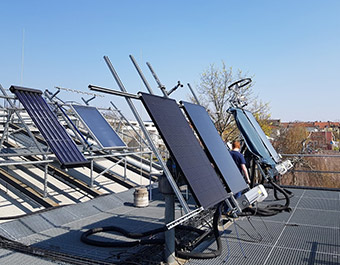The SolWP-Hybrid project is combining solar and heat pump systems, and heat and electrical energy storage, to provide residential buildings with an efficient and sustainable energy supply.
SolWP-Hybrid: Hybrid solar and heat pump systems for energy-efficient buildings in Germany
- 19 November 2019
Within SolWP–Hybrid we are focusing on the systematic analysis of solar and heat pump systems as hybrid systems for the heat and electricity supply of future residential buildings with a high share of renewable energies. We are combining photovoltaic-thermal (PVT) collectors and heat pumps with thermal and electrical energy storage. Our team has different areas of expertise – practical implementation, modelling and control – and works with market partners to ensure the practicability of our results.
Combining solar and heat pump systems is a promising way of achieving greater energy efficiency and flexibility in buildings. Combined with energy storage technologies, it can overcome the drawbacks of standalone energy sources, such as fluctuating availability or temporary low efficiency.
SolWP-Hybrid is analysing hybrid solar and heat pump systems with photovoltaic-thermal (PVT) collectors and heat pumps (air, ground or ice storage source heat pump systems). Such innovative technologies make it possible to link a building’s heat and electrical systems for energy generation and consumption.
Overcoming power fluctuations
Storage capability is important for balancing energy supply and demand. The project is focusing on thermal and electrical energy storage systems in or near buildings. Relatively small storage facilities near to the point of energy production in buildings, so-called decentralised storage, can help balance fluctuations more efficiently, with lower energy transmission costs.
The research team is carrying out detailed modelling and analysis of different system concepts. It will evaluate efficiency, the amount of self-consumption of photovoltaic (PV) energy and self-sufficiency. The economic and environmental impacts for different system designs and conditions, such as locations and types of building, will be analysed. The team is investigating the hydraulic integration of PVT collectors and comparing different PVT concepts and combinations of separated solar thermal collectors and PV modules.
Modeling, simulation and laboratory investigations
SolWP-Hybrid is developing strategies for optimised energy management; testing simulation models; and carrying out whole system analysis in the lab. The development of system models is nearly complete and the first results have been published. The preliminary results show the models are valid and can be used for subsequent system simulations. The ongoing construction of the whole system test bed will allow for demonstration and analysis of the system in real applications.
Preventing climate change is an increasing priority. The transition to a highly energy efficient and low carbon economy will depend on new technologies, including for renewable energy. In the building sector, the EU has set a requirement of near-zero-energy buildings, with energy from renewable sources as standard for all new buildings, by 2021. According to the European Commission, buildings are responsible for approximately 40 % of energy consumption and 36 % of CO2 emissions in the EU.
Total investment and EU funding
Total investment for the project “SolWP-Hybrid” is EUR 931 049, with the EU’s European Regional Development Fund contributing EUR 465 525 through the “Saarland” Operational Programme for the 2014-2020 programming period. The investment falls under the priority “Strengthening of research, technological development and innovation”.

